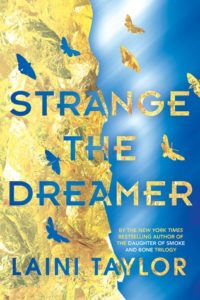
Laini Taylor
Little, Brown Books for Young Readers
Published on March 28, 2017

Amazon | Barnes & Noble | Goodreads
About Strange the Dreamer
The dream chooses the dreamer, not the other way around—and Lazlo Strange, war orphan and junior librarian, has always feared that his dream chose poorly. Since he was five years old he’s been obsessed with the mythic lost city of Weep, but it would take someone bolder than he to cross half the world in search of it. Then a stunning opportunity presents itself, in the person of a hero called the Godslayer and a band of legendary warriors, and he has to seize his chance or lose his dream forever.
What happened in Weep two hundred years ago to cut it off from the rest of the world? What exactly did the Godslayer slay that went by the name of god? And what is the mysterious problem he now seeks help in solving?
The answers await in Weep, but so do more mysteries—including the blue-skinned goddess who appears in Lazlo’s dreams. How did he dream her before he knew she existed? And if all the gods are dead, why does she seem so real?
My Review
It took me a long time to read Strange the Dreamer because I loved Daughter of Smoke and Bone so much that I worried Strange wouldn’t measure up or would make me miss the other series too much. I know. I always do this to myself! And then usually, it’s all good, and I enjoy the new book or series anyway. And, surprise! I enjoyed this book, too.
I love the way Taylor creates broad, deep story worlds and draws readers into cultural conflicts and explores values where they come from. Both Lazlo and Sarai pretty much had me at hello. I loved them both, but especially Lazlo for his enthusiasm and his desire to help others. Of course the tragic Godslayer had me at his first appearance, too.
The only thing that really made me stumble is the omniscient point-of-view in which the story is told. It’s consistent and adds a lot to the novel, so I totally get why Strange the Dreamer is written this way, but omniscient isn’t my favorite. So whenever there would be those zoom-out moments where we get a god’s-eye view of what’s happening in all the heads of all the people, I kind of had to blink a few times and re-settle into the story. Totally worth it, though.
Strange the Dreamer is a bit more of an adult story than I remember Daughter of Smoke and Bone being. It feels heavier and definitely more adult in the way the characters romantic relationships progress. I guess I felt like Karou in Daughter of Smoke and Bone really feels young, and that anchored the story in the young adult genre for me. Again, not sorry I read the book, but thought that needed brief noting.
So that’s it! Check the content below and happy reading!
Cultural Elements
Since this is a fantasy, there are made up races and ethnicities. The story begins in a more temperate climate with a brown-skinned people and progresses to a desert climate of brown-skinned people. A separate race of gods have blue skin.
Profanity/Crude Language Content
None.
Romance/Sexual Content
Some very sensual scenes showing kissing between girl and boy. Two female characters also have a relationship and share sleeping space. There are some references to sex but no descriptions of it directly.
The gods took human slaves and used them to bear their children. No descriptions of this, but obviously the survivors bear some trauma from the experience.
Spiritual Content
A blue race of humans have magical abilities (one specific ability each) and call themselves gods.
Violent Content
The story begins and ends with a young woman’s death. She falls and is impaled on a gate. Before the story begins, a man brutally kills the gods, even their small children and babies. No descriptions other than that they babies screamed and suddenly went silent.
See romance content about the gods and their treatment of human slaves.
In one scene, ghosts attack a group of humans.
Drug Content
Some references to drinking alcohol.